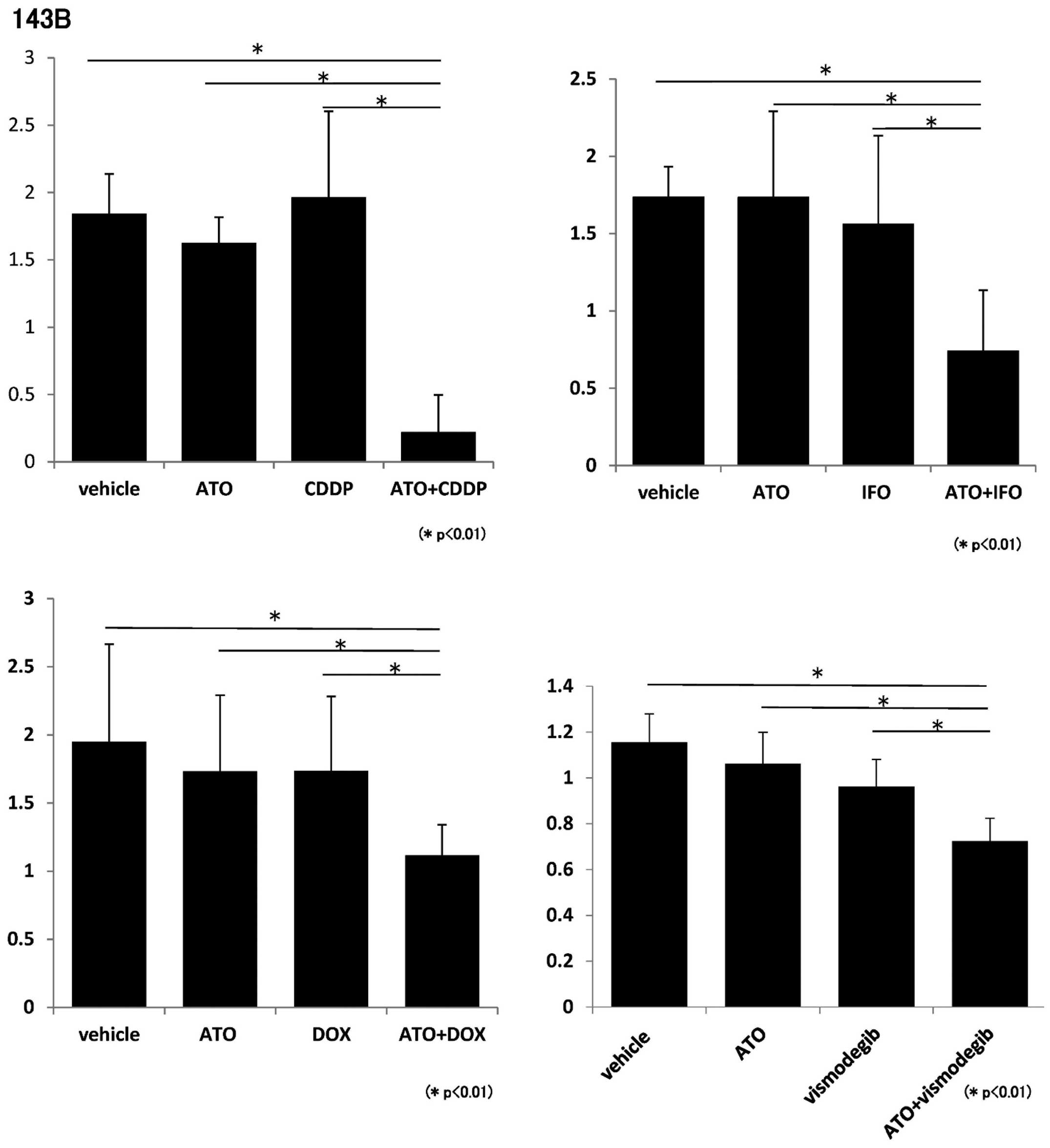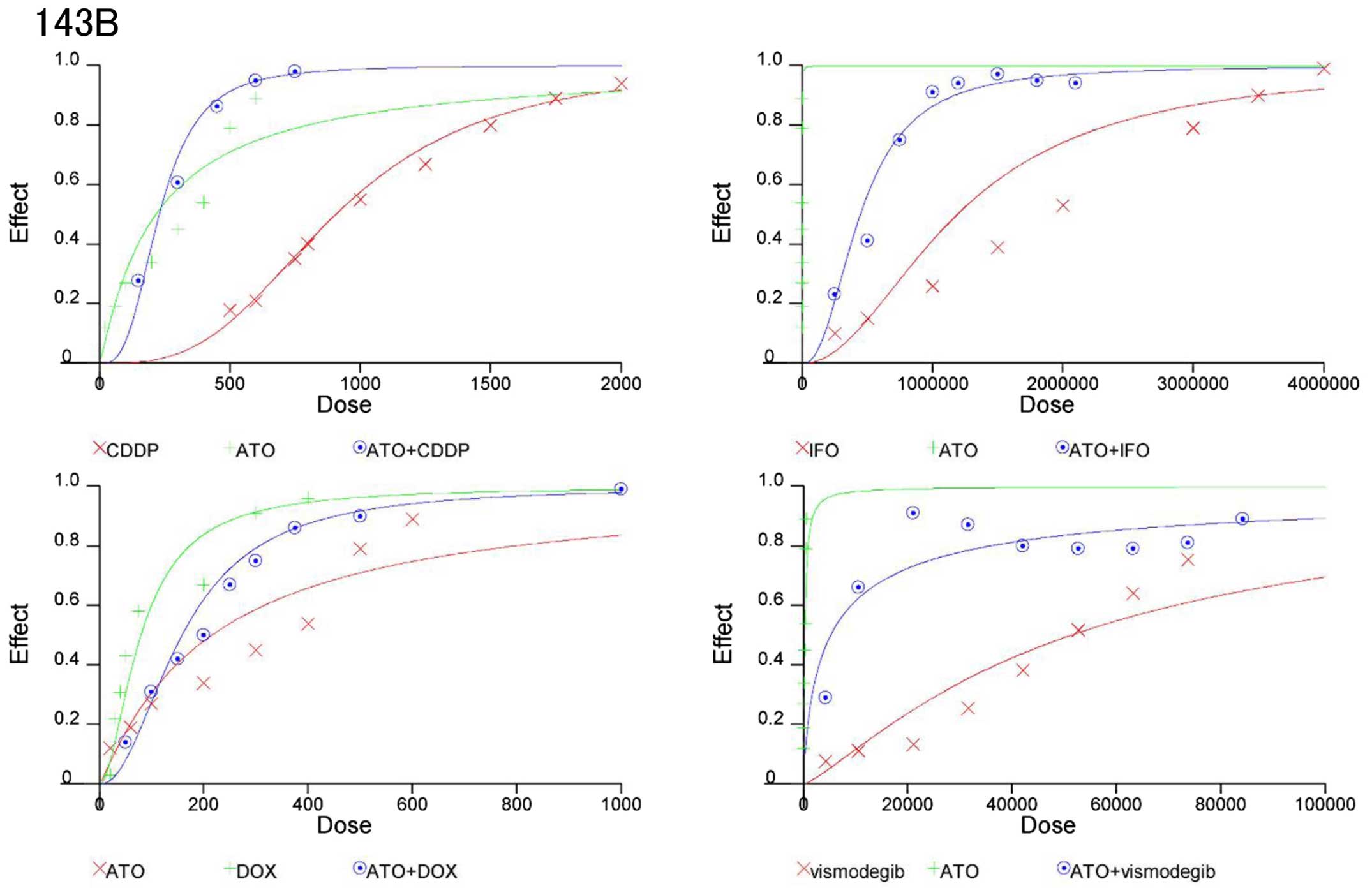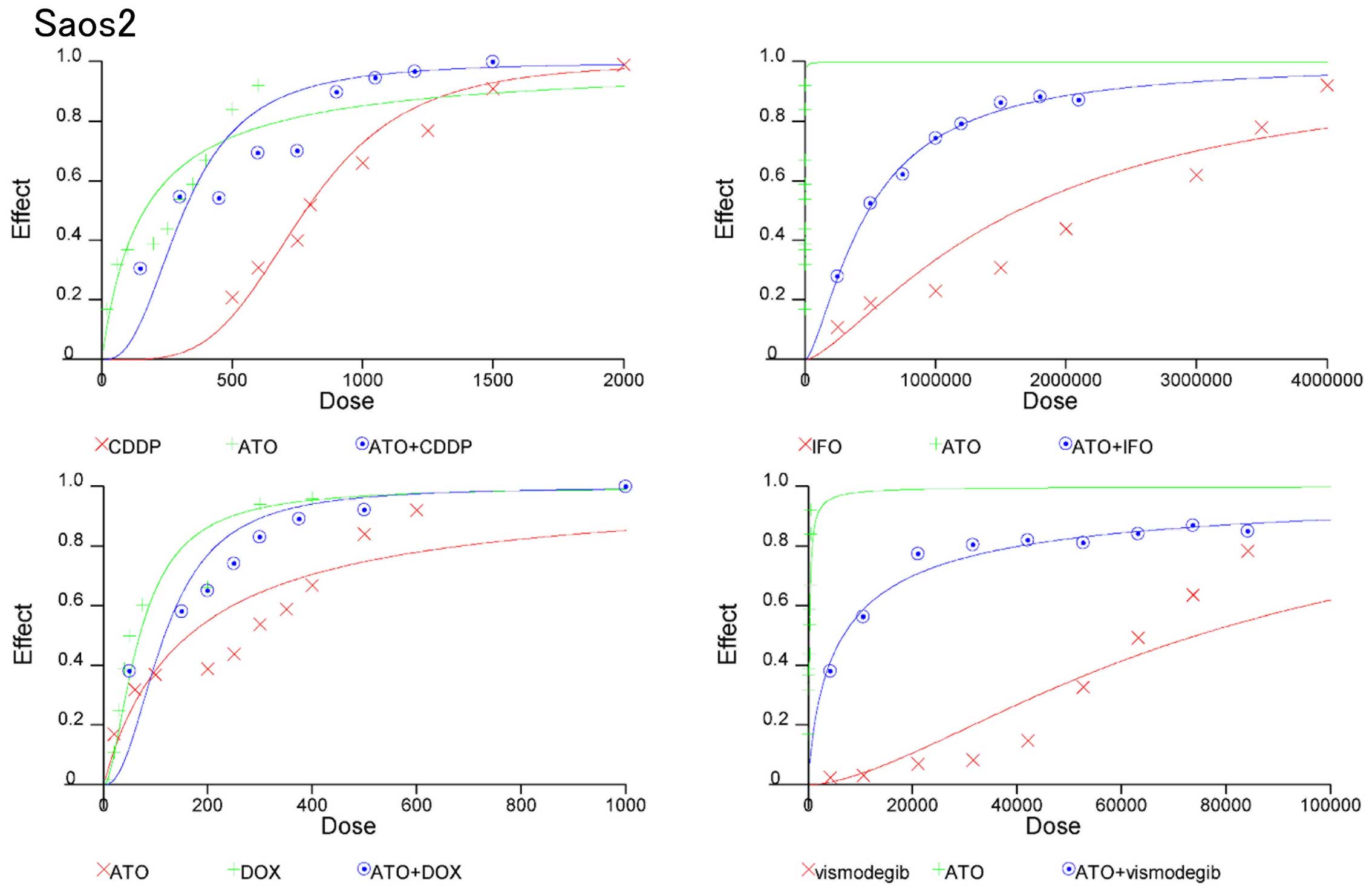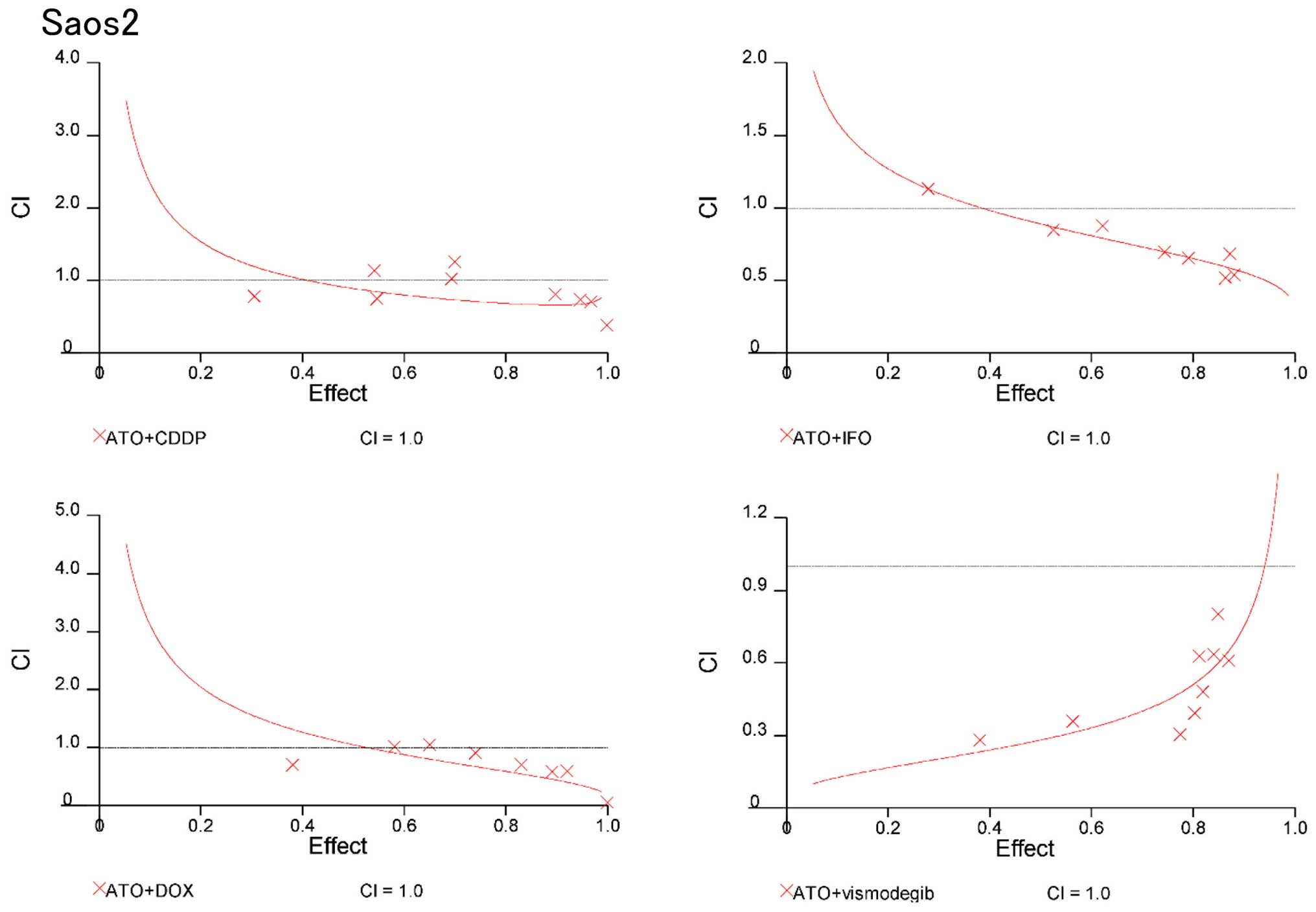Combination of Hedgehog inhibitors and standard anticancer agents synergistically prevent osteosarcoma growth
- Authors:
- Published online on: November 6, 2015 https://doi.org/10.3892/ijo.2015.3236
- Pages: 235-242
Abstract
Introduction
Osteosarcoma is the most commonly diagnosed primary malignant tumor of the bone in children and adolescents (1,2). High-dose chemotherapy and surgical intervention have improved long-term prognosis for non-metastatic disease to ~50–80% (3). However, a high number of patients with osteosarcoma have a strong tendency of lung metastasis. Metastatic osteosarcoma exhibits resistance to standard chemotherapy (4).
To establish new chemotherapies to improve prognosis, many investigators have researched the molecular mechanisms of osteosarcoma growth and metastasis. We and others have investigated the function of the Hedgehog pathway in osteosarcoma. The Hedgehog pathway plays important roles in embryonic development and adult organ homeostasis and regeneration (5,6). Binding of Hedgehog ligands (sonic, Indian, and desert Hedgehog) to patched1 (PTCH1) promotes release of smoothened (SMO), which then leads to nuclear translocation and activation of GLI transcription factors (GLI1/-2/-3). GLI promotes transcription of target genes, including GLI1, HHIP, PTCH1, CYCLIN D, BCL2 and SNAIL (7). We and others reported that inhibition of smoothened (SMO) or GLI family zinc finger 2 (GLI2) prevents osteosarcoma growth and invasion in vitro and in vivo (8–12).
Arsenic trioxide (ATO) is a Food and Drug Administration (FDA)-approved reagent that is used to treat acute promyelocytic leukemia (APL) patients (13). Recently, ATO was proposed as a potentially useful inhibitor of Hedgehog-driven cancers including osteosarcoma (11,14,15). Furthermore, an SMO inhibitor, vismodegib, has been approved for basal cell carcinoma treatment (16). To apply our previous findings in clinical settings, we examined the effects of Hedgehog inhibitors combined with standard anticancer agents. Our findings showed that combination of Hedgehog inhibitors or combination of ATO and standard anticancer agents prevent osteosarcoma growth in vitro and in vivo.
Materials and methods
Cell lines and reagents
The human osteosarcoma cell lines 143B and Saos-2 were obtained from the American Type Culture Collection (ATCC; Manassas, VA, USA). Cell lines were cultured at 37°C in 5% CO2. Cisplatin (CDDP), ifosfamide (IFO), and doxorubicin (DOX) were purchased from Sigma-Aldrich (St. Louis, USA), (Shionogi & Co., Ltd., Osaka, Japan). ATO (Trisenox) was purchased from Nippon Shinyaku Co., Ltd. (Tokyo, Japan). Vismodegib (GDC-0449) was purchased from LC Laboratories (Woburn, MA, USA).
Analysis of cell viability
Cells were treated with ADM, CDDP, IFO, vismodegib and ATO. After 48 h, cell viability was evaluated by colorimetric assay for mitochondrial dehydrogenase activity, as described previously (15) (WST-1; Roche, Basel, Switzerland).
Animal studies
Examinations of xenograft models were performed as previously reported (9,15). For ATO and CDDP or ATO and IFO examinations, 143B cells (1×106) were suspended in 100 μl of Matrigel (BD, NJ, USA). Suspensions of 143B osteosarcoma cells were subcutaneously inoculated in 5-week-old nude mice. For ATO and vismodegib examination, 143B cell (1×106) suspensions were inoculated into the left knee joint of 5-week-old nude mice. Tumor volume was calculated using the formula LW2/2 (L and W indicating the length and width of tumors).
Xenograft models were randomly treated with ATO, CDDP, IFO, and vismodegib or an equal volume of vehicle as control. All animal experiments were performed in compliance with the guidelines of the Institute of Laboratory Animal Sciences, Graduate School of Medical and Dental Sciences, Kagoshima University. Every effort was employed to minimize both the number of animals used and animal pain.
Drug combination studies
Synergism after treatment with Hedgehog inhibitors and standard chemotherapeutic reagents was evaluated using CalcuSyn software (Biosoft, Ferguson, MO, USA), which is based on the median-effect principle applied by Chou and Talalay (17). From the fraction affected by the dose (Fa) obtained from cell proliferation assays and the dose of drug (D), the software draws a dose effect curve and calculates the median-effect dose (Dm). Dm is same as ED50. For each combinative dose effect, a combination-index (CI) was generated. The effects of the combinations were then transformed into and displayed as fraction-affected CI plots. If the data of single-agent and combination use is inputted, the software calculates the CI, which represents of the pharmacological interaction of two drugs. A CI value of 1 indicated an additive effect between the two agents, whereas a CI<1 or CI>1 indicated synergism or antagonism, respectively.
Statistical analysis
Statistical analyses were performed using Kruskal-Wallis tests with Excel Statistics 2012 and 2015 (SSRI, Tokyo, Japan). P-values of <0.05 were considered statistically significant.
Results
Combination of Hedgehog inhibitors and standard anticancer agents prevents proliferation of osteosarcoma cells
We evaluated the effect of anticancer agents including CDDP, IFO, and DOX, which are standard chemotherapeutic reagents for osteosarcoma patients in Japan (18). To determine whether ATO and standard anticancer agents prevent the proliferation of osteosarcoma cells, we performed WST-1 assays using ATO, CDDP, IFO, and DOX. WST-1 assays showed that proliferation of 143B and Saos2 cells was inhibited by ATO and each standard chemotherapeutic reagent (Figs. 1 and 2). We next evaluated the effects of a combination of Hedgehog inhibitors using ATO and vismodegib. SMO inhibitor, vismodegib, was approved for the treatment of basal cell carcinoma (BCC) in 2012 and is undergoing clinical trials for metastatic cancer and advanced cancer (16,19). WST-1 assays showed that 143B and Saos2 cell proliferation was inhibited by ATO and vismodegib (Figs. 1 and 2). These findings showed that combination of ATO and chemotherapeutic reagents prevents proliferation of osteosarcoma cells in vitro.
Combination of Hedgehog inhibitors and standard chemotherapeutic reagents prevent osteosarcoma cell proliferation synergistically
On the basis of these findings, we evaluated whether combinations of ATO and standard chemotherapeutic reagents could be synergistic to prevent osteosarcoma growth. CIs were used to examine synergism after treatment with Hedgehog inhibitors and standard chemotherapeutic reagents (17). CI values and the degree of drug interaction were evaluated by CalcuSyn software. The effects of the combinations in 143B and Saos2 cells were then calculated and presented in a dose-effect plot (Figs. 3 and 4) and fraction-affected CI plots (Figs. 5 and 6). CIs of ATO with CDDP, IFO, or DOX at ED50–90 (the average CI at ED50 to ED90) of 143B cells were 0.41, 061, and 0.84, respectively (Table IA). CIs of ATO and CDDP, IFO, or DOX for ED50–90 of Saos2 were 0.75, 0.71, and 0.72, respectively (Table IB). Synergistic effects were observed for all concentrations except for combination of DOX at the ED50 in 143B and Saos2 cells. Next, we examined the combination effects of Hedgehog inhibitors using ATO and vismodegib. Synergic effects were observed at ED50 to ED90 of 143B and Saos2 cells (Table I). These findings suggest that combination of Hedgehog inhibitors and standard chemotherapeutic reagents prevent osteosarcoma cell proliferation synergistically.
Combination therapy of Hedgehog pathway inhibitors and standard chemotherapeutic reagents in osteosarcoma cells in vivo
Nude mice were inoculated with 143B osteosarcoma cells. ATO, IFO, CDDP, or vismodegib were intraperitoneally administered, as previously reported (11,15,20). Because intraperitoneal DOX treatment induces severe peritonitis, intravenous administration of DOX is recommended (20). Our preliminary experiment showed intravenous treatment could not achieve reproducibility because of vascular leak and vascular occlusion. Compared with vehicle treatment, treatment with ATO and CDDP or IFO significantly prevented tumor growth (Fig. 7A and B). Next, we examined the combined effect of Hedgehog inhibitors, ATO and vismodegib. Compared with the vehicle control, ATO, or vismodegib treatment, combination of ATO and vismodegib significantly prevented tumor growth (Fig. 7C). These findings suggest that the combined administration of ATO and standard chemotherapeutic reagents might be effective in the treatment of osteosarcoma.
Discussion
Aberrant activation of the Hedgehog pathway due to mutations of regulatory components or without driver mutations have been reported in many malignancies (21–28). Although treatment with vismodegib substantially benefited patients with advanced basal cell carcinoma (29), there have been disappointing reports for vismodegib from trials in colorectal and ovarian cancers (30,31) and clinical trials of saridegib (a SMO inhibitor) were halted because of failures in pancreatic cancer, myelofibrosis and chondrosarcoma (28). In addition, mutations in SMO and Sufu heterozygous mice have been shown to be unresponsive to SMO inhibitors (28,32). Non-Hedgehog pathway-mediated activation of GLI transcription has been also reported (28). These findings suggest that additional approaches should be considered for Hedgehog inhibition therapy for malignancy. Accordingly, ATO, which inhibits GLI transcription, may be a more effective Hedgehog targeting agent.
We and others reported that SMO and GLI2 were overexpressed in human osteosarcoma specimens (8,9,12). Upregulated expression levels of GLI2 correlated with lung metastasis and poor survival of osteosarcoma patients (11,12). Inhibition of GLI2 or SMO prevents osteosarcoma growth both in vitro and in vivo (8,9). ATO inhibits the activation of Hedgehog signaling and promotes apoptotic cell death in osteosarcoma cells (15). We used ATO at 10 mg/kg body weight intraperitoneally, as previously reported (33). However, the concentration of ATO used in vivo was two-fold greater than that used for human APL therapy (34). To decrease the ATO concentration, combinations of Hedgehog inhibitors and standard anticancer drugs were examined. Our findings showed that combined treatment of ATO with CDDP, IFO, or DOX prevents osteosarcoma proliferation synergistically in vitro. In vivo examinations showed that statistical differences in tumor size were observed between the vehicle and combinations of ATO with CDDP or ATO with IFO. These findings suggest that combination therapy might decrease the effective concentration of each drug. The lower levels of reagents that could be used in these combinations might reduce toxicities associated with effective use of a single drug.
Kim et al reported that combined use of ATO and itraconazole, a SMO inhibitor, enables a reduced dose of ATO and itraconazol to prevent medulloblastoma and basal cell carcinoma growth (35). Consistent with this report, we showed that combined use of ATO with vismodegib permits a reduced dose of both ATO and vismodegib, and inhibited osteosarcoma growth synergistically in vitro and in vivo. Although the majority of side effects of vismodegib are not so severe, >50% of patients discontinued their drug treatment because of side effect concerns for long-term compliance (16,36). Combination of ATO with vismodegib might decrease the effective concentration of each drug. The lower levels of reagents that could be used in these combinations might reduce toxicity.
Because osteosarcoma is an extremely heterogeneous and genomically unstable tumor (37), preselection of osteosarcoma patients with activated Hedgehog is required before treatment with Hedgehog inhibitors. Shou et al developed a five-gene Hedgehog signature for patient preselection for Hedgehog inhibitor therapy in medulloblastoma (38). This method might be useful for other Hedgehog-activated malignancies including osteosarcoma.
There is a possibility that the pleotropic effect of ATO and off-target effects of SMO might affect the growth inhibition of osteosarcoma. Nonetheless, combinations of ATO with vismodegib or standard anticancer reagents showed promising therapeutic efficacy for osteosarcoma.
Taken together, these findings indicate that combination of Hedgehog pathway inhibitors and standard FDA-approved anticancer agents with established safety profiles for human use may be an attractive therapeutic method for treating osteosarcoma.
Acknowledgements
We are grateful to Hui Gao for her excellent technical assistance. We wish to thank the joint research laboratory of Kagoshima University Graduate School of Medical and Dental Sciences. This study was supported by Grants-in-Aid for Scientific Research (KAKENHI) (C) 19591725, (C) 20591786, (C) 21591919, (C) 21591920, (C) 22591663, and (C) 23592195, a Grant-in-Aid from the Ministry of Health, Labour and Welfare of Japan for the Third Term Comprehensive Control Research for Cancer, and Scientific Research on Priority Areas 201201976 to H. Nagao from the Grants-in-Aid for JSPS Fellows. We thank for Edanz Group Japan for English Editing service.
Abbreviations:
|
ATO |
arsenic trioxide |
|
PTCH1 |
patched1 |
|
SMO |
smoothened |
|
SUFU |
suppressor of fused |
|
GLI |
glioma-associated oncogene homolog |
|
FDA |
Food and Drug Administration |
|
APL |
acute promyelocytic leukemia |
|
ACTB |
actin-beta |
References
|
Sweetnam R: Osteosarcoma. Br J Hosp Med. 28:112116–121. 1982.PubMed/NCBI | |
|
Dorfman HD and Czerniak B: Bone cancers. Cancer. 75(Suppl): 203–210. 1995. View Article : Google Scholar : PubMed/NCBI | |
|
Hegyi M, Semsei AF, Jakab Z, Antal I, Kiss J, Szendroi M, Csoka M and Kovacs G: Good prognosis of localized osteosarcoma in young patients treated with limb-salvage surgery and chemotherapy. Pediatr Blood Cancer. 57:415–422. 2011. View Article : Google Scholar : PubMed/NCBI | |
|
He JP, Hao Y, Wang XL, Yang XJ, Shao JF, Guo FJ and Feng JX: Review of the molecular pathogenesis of osteosarcoma. Asian Pac J Cancer Prev. 15:5967–5976. 2014. View Article : Google Scholar : PubMed/NCBI | |
|
Nybakken K and Perrimon N: Hedgehog signal transduction: Recent findings. Curr Opin Genet Dev. 12:503–511. 2002. View Article : Google Scholar : PubMed/NCBI | |
|
Petrova R and Joyner AL: Roles for Hedgehog signaling in adult organ homeostasis and repair. Development. 141:3445–3457. 2014. View Article : Google Scholar : PubMed/NCBI | |
|
Briscoe J and Thérond PP: The mechanisms of Hedgehog signalling and its roles in development and disease. Nat Rev Mol Cell Biol. 14:416–429. 2013. View Article : Google Scholar : PubMed/NCBI | |
|
Hirotsu M, Setoguchi T, Sasaki H, Matsunoshita Y, Gao H, Nagao H, Kunigou O and Komiya S: Smoothened as a new therapeutic target for human osteosarcoma. Mol Cancer. 9:52010. View Article : Google Scholar : PubMed/NCBI | |
|
Nagao H, Ijiri K, Hirotsu M, Ishidou Y, Yamamoto T, Nagano S, Takizawa T, Nakashima K, Komiya S and Setoguchi T: Role of GLI2 in the growth of human osteosarcoma. J Pathol. 224:169–179. 2011. View Article : Google Scholar : PubMed/NCBI | |
|
Nagao-Kitamoto H, Setoguchi T, Kitamoto S, Nakamura S, Tsuru A, Nagata M, Nagano S, Ishidou Y, Yokouchi M, Kitajima S, et al: Ribosomal protein S3 regulates GLI2-mediated osteosarcoma invasion. Cancer Lett. 356B:855–861. 2015. View Article : Google Scholar | |
|
Nagao-Kitamoto H, Nagata M, Nagano S, et al: GLI2 is a novel therapeutic target for metastasis of osteosarcoma. Int J Cancer. 136:1276–1284. 2015. View Article : Google Scholar | |
|
Yang W, Liu X, Choy E, Mankin H, Hornicek FJ and Duan Z: Targeting hedgehog-GLI-2 pathway in osteosarcoma. J Orthop Res. 31:502–509. 2013. View Article : Google Scholar | |
|
Nasr R, Guillemin MC, Ferhi O, Soilihi H, Peres L, Berthier C, Rousselot P, Robledo-Sarmiento M, Lallemand-Breitenbach V, Gourmel B, et al: Eradication of acute promyelocytic leukemia-initiating cells through PML-RARA degradation. Nat Med. 14:1333–1342. 2008. View Article : Google Scholar : PubMed/NCBI | |
|
Beauchamp EM, Ringer L, Bulut G, Sajwan KP, Hall MD, Lee YC, Peaceman D, Ozdemirli M, Rodriguez O, Macdonald TJ, et al: Arsenic trioxide inhibits human cancer cell growth and tumor development in mice by blocking Hedgehog/GLI pathway. J Clin Invest. 121:148–160. 2011. View Article : Google Scholar : | |
|
Nakamura S, Nagano S, Nagao H, Ishidou Y, Yokouchi M, Abematsu M, Yamamoto T, Komiya S and Setoguchi T: Arsenic trioxide prevents osteosarcoma growth by inhibition of GLI transcription via DNA damage accumulation. PLoS One. 8:e694662013. View Article : Google Scholar : PubMed/NCBI | |
|
Sekulic A, Migden MR, Oro AE, Dirix L, Lewis KD, Hainsworth JD, Solomon JA, Yoo S, Arron ST, Friedlander PA, et al: Efficacy and safety of vismodegib in advanced basal-cell carcinoma. N Engl J Med. 366:2171–2179. 2012. View Article : Google Scholar : PubMed/NCBI | |
|
Chou TC and Talalay P: Quantitative analysis of dose-effect relationships: The combined effects of multiple drugs or enzyme inhibitors. Adv Enzyme Regul. 22:27–55. 1984. View Article : Google Scholar : PubMed/NCBI | |
|
Iwamoto Y and Tanaka K: The activity of the Bone and Soft Tissue Tumor Study Group of the Japan Clinical Oncology Group. Jpn J Clin Oncol. 42:467–470. 2012. View Article : Google Scholar : PubMed/NCBI | |
|
Keating GM: Vismodegib: In locally advanced or metastatic basal cell carcinoma. Drugs. 72:1535–1541. 2012. View Article : Google Scholar : PubMed/NCBI | |
|
Budach W, Budach V, Stuschke M, Schmauder B, Reipke P and Scheulen ME: Efficacy of ifosfamide, dacarbazine, doxorubicin and cisplatin in human sarcoma xenografts. Br J Cancer. 70:29–34. 1994. View Article : Google Scholar : PubMed/NCBI | |
|
Gailani MR, Ståhle-Bäckdahl M, Leffell DJ, Glynn M, Zaphiropoulos PG, Pressman C, Undén AB, Dean M, Brash DE, Bale AE, et al: The role of the human homologue of Drosophila patched in sporadic basal cell carcinomas. Nat Genet. 14:78–81. 1996. View Article : Google Scholar : PubMed/NCBI | |
|
Xie J, Murone M, Luoh SM, Ryan A, Gu Q, Zhang C, Bonifas JM, Lam CW, Hynes M, Goddard A, et al: Activating smoothened mutations in sporadic basal-cell carcinoma. Nature. 391:90–92. 1998. View Article : Google Scholar : PubMed/NCBI | |
|
Slade I, Murray A, Hanks S, Kumar A, Walker L, Hargrave D, Douglas J, Stiller C, Izatt L and Rahman N: Heterogeneity of familial medulloblastoma and contribution of germline PTCH1 and SUFU mutations to sporadic medulloblastoma. Fam Cancer. 10:337–342. 2011. View Article : Google Scholar | |
|
Raffel C, Jenkins RB, Frederick L, Hebrink D, Alderete B, Fults DW and James CD: Sporadic medulloblastomas contain PTCH mutations. Cancer Res. 57:842–845. 1997.PubMed/NCBI | |
|
Reifenberger J, Wolter M, Weber RG, Megahed M, Ruzicka T, Lichter P and Reifenberger G: Missense mutations in SMOH in sporadic basal cell carcinomas of the skin and primitive neuroectodermal tumors of the central nervous system. Cancer Res. 58:1798–1803. 1998.PubMed/NCBI | |
|
Taylor MD, Liu L, Raffel C, Hui CC, Mainprize TG, Zhang X, Agatep R, Chiappa S, Gao L, Lowrance A, et al: Mutations in SUFU predispose to medulloblastoma. Nat Genet. 31:306–310. 2002. View Article : Google Scholar : PubMed/NCBI | |
|
Scales SJ and de Sauvage FJ: Mechanisms of Hedgehog pathway activation in cancer and implications for therapy. Trends Pharmacol Sci. 30:303–312. 2009. View Article : Google Scholar : PubMed/NCBI | |
|
Amakye D, Jagani Z and Dorsch M: Unraveling the therapeutic potential of the Hedgehog pathway in cancer. Nat Med. 19:1410–1422. 2013. View Article : Google Scholar : PubMed/NCBI | |
|
Basset-Seguin N, Hauschild A, Grob JJ, Kunstfeld R, Dréno B, Mortier L, Ascierto PA, Licitra L, Dutriaux C, Thomas L, et al: Vismodegib in patients with advanced basal cell carcinoma (STEVIE): A pre-planned interim analysis of an international, open-label trial. Lancet Oncol. 16:729–736. 2015. View Article : Google Scholar : PubMed/NCBI | |
|
Berlin J, Bendell JC, Hart LL, Firdaus I, Gore I, Hermann RC, Mulcahy MF, Zalupski MM, Mackey HM, Yauch RL, et al: A randomized phase II trial of vismodegib versus placebo with FOLFOX or FOLFIRI and bevacizumab in patients with previously untreated metastatic colorectal cancer. Clin Cancer Res. 19:258–267. 2013. View Article : Google Scholar | |
|
Kaye SB, Fehrenbacher L, Holloway R, Amit A, Karlan B, Slomovitz B, Sabbatini P, Fu L, Yauch RL, Chang I, et al: A phase II, randomized, placebo-controlled study of vismodegib as maintenance therapy in patients with ovarian cancer in second or third complete remission. Clin Cancer Res. 18:6509–6518. 2012. View Article : Google Scholar : PubMed/NCBI | |
|
Lee Y, Kawagoe R, Sasai K, Li Y, Russell HR, Curran T and McKinnon PJ: Loss of suppressor-of-fused function promotes tumorigenesis. Oncogene. 26:6442–6447. 2007. View Article : Google Scholar : PubMed/NCBI | |
|
Kim J, Lee JJ, Kim J, Gardner D and Beachy PA: Arsenic antagonizes the Hedgehog pathway by preventing ciliary accumulation and reducing stability of the Gli2 transcriptional effector. Proc Natl Acad Sci USA. 107:13432–13437. 2010. View Article : Google Scholar : PubMed/NCBI | |
|
Shen ZX, Chen GQ, Ni JH, Li XS, Xiong SM, Qiu QY, Zhu J, Tang W, Sun GL, Yang KQ, et al: Use of arsenic trioxide (As2O3) in the treatment of acute promyelocytic leukemia (APL): II. Clinical efficacy and pharmacokinetics in relapsed patients. Blood. 89:3354–3360. 1997.PubMed/NCBI | |
|
Kim J, Aftab BT, Tang JY, Kim D, Lee AH, Rezaee M, Kim J, Chen B, King EM, Borodovsky A, et al: Itraconazole and arsenic trioxide inhibit Hedgehog pathway activation and tumor growth associated with acquired resistance to smoothened antagonists. Cancer Cell. 23:23–34. 2013. View Article : Google Scholar : PubMed/NCBI | |
|
Tang JY, Mackay-Wiggan JM, Aszterbaum M, Yauch RL, Lindgren J, Chang K, Coppola C, Chanana AM, Marji J, Bickers DR, et al: Inhibiting the hedgehog pathway in patients with the basal-cell nevus syndrome. N Engl J Med. 366:2180–2188. 2012. View Article : Google Scholar : PubMed/NCBI | |
|
Kuijjer ML, Hogendoorn PC and Cleton-Jansen AM: Genomewide analyses on high-grade osteosarcoma: making sense of a genomically most unstable tumor. Int J Cancer. 133:2512–2521. 2013.PubMed/NCBI | |
|
Shou Y, Robinson DM, Amakye DD, Rose KL, Cho YJ, Ligon KL, Sharp T, Haider AS, Bandaru R, Ando Y, et al: A five-gene hedgehog signature developed as a patient preselection tool for hedgehog inhibitor therapy in medulloblastoma. Clin Cancer Res. 21:585–593. 2015. View Article : Google Scholar |
















